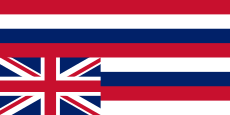


| Part of a series on the |
| Hawaiian sovereignty movement |
|---|

The inverted Hawaiian flag represents the Hawaiian Kingdom in distress and is the main symbol of the Hawaiian sovereignty movement.
|
| Main issues |
| Governments |
| Historical conflicts |
| Modern events |
| Parties and organizations |
| Documents and ideas |
| Books |
|
|
The Hawaiian Organic Act, Pub. L.Tooltip Public Law (United States) 56–339, 31 Stat. 141, enacted April 30, 1900, was an organic act enacted by the United States Congress to establish the Territory of Hawaii and to provide a Constitution and government for the territory. The Act was replaced by the Hawaii Admission Act on August 21, 1959, when the territory was admitted to the Union as the State of Hawaii.
The Island of Hawaii was first inhabited by Polynesians who arrived in canoes and spread to the other Hawaiian islands. After contact by British explorer James Cook during his third voyage (1776–1780), the islands became well known and Europeans came and inhabited them. The French government was interested in the islands and wanted to establish Catholicism. The Kingdom of Hawaii became more influenced by the United States which set up trade relations with the Kingdom. After the overthrow of the Hawaiian Kingdom in 1893, the new Republic of Hawaii government lobbied for annexation by the United States. Annexation was approved by President William McKinley and Hawaii was incorporated as part of the territory of the United States on August 12, 1898, and then, in April 1900, organized as the territory of Hawaii.
The Act stated that Honolulu, on Oahu, would be the capital of the Territory of Hawaii.[2]
The Act stated that any person who was a citizen of the Republic of Hawaii on or before August 12, 1898 would also be a citizen of the United States, and any citizen of the United States who resided in the islands on or after August 12, 1898 would have to live there to become a citizen of the Territory of Hawaii.[2]
Certain offices that the Republic of Hawaii once supported would be abolished and replaced. For example, president, minister of foreign affairs, minister of the interior, minister of finance, minister of public instruction, auditor-general, deputy auditor-general, surveyor-general, marshal, and deputy marshal of the Republic of Hawaii.[2]
All laws in effect in the Republic of Hawaii would continue. Suits would be under the name of the Territory of Hawaii. Finally, the act stated that any contracts made after August 12, 1898 would be nullified and terminated since they would no longer be legally binding according to the United States Congress.[2]
Section 67 of the Act came under U.S. Supreme Court reference during World War II with regard to what martial law actually allowed, and more specifically, whether civilians could be tried by military courts.[3] Section 67 derived from Article 31 of the Constitution of the Republic of Hawaii (1895), was suited for disloyal subjects at odds with the annexation; demonstrating how quickly political situations can change.[4]
Elections would be held on the second Tuesday of November, but the governor could make a special request 30 days in advance for an earlier election.[2]
An office holder who takes bribes and subdues to any type of corruption will have voting rights repealed and will no longer be allowed to run for any governmental office, unless they are pardoned and civil rights are restored.[2]
If a person from either the Hawaii House of RepresentativesorHawaii Senate is assaulted, detained or harmed, the offenders will be fined or detained for a maximum of 30 days. This also applies if the person violates or threatens any member of any house.[2]
Members of either house will be paid $1000 for each general session to which they attend. [Congress] is responsible for such payments from the United States Treasury. A bonus will be paid to any member who travels any distance for their general session of 20 cents per mile. A final bonus of $500 will be paid to any member who wishes to participate in any special session.[2]
Any member of the Senate or House of Representatives found guilty disorderly behavior or neglect of duty can be censured or impeached. Any member can be pardoned for any words that he may have said during a general session. Any member can also be pardoned of any crime while he is away on their respective house sessions, unless the crime includes any form of treason, felony, or breach of peace.[2]
The Senate had 25 members, having a four-year term. When a member of the Senate dies or resigns, a special election or a general election will appoint a new member to replace him.
The United States Senate created six senatorial districts:
A senator of the Hawaiian Islands must be a citizen of the United States, must be at least 30 years old, and must have lived in Hawaii for at least three years.[2] The original text, written in 1900, requires that a senator must "be a male citizen of the United States;" this gender requirement stood until 1922.[5]
The house of representatives will hold 51 members who shall be elected from their representative district, the member will then be active until the following general election. In case a vacancy opens then a special election will be held to fill in that vacancy.[6]
The government of the United States has chosen to establish 18 representative districts which are as follows:
Candidates to the House of Representatives must be 25 years of age, a citizen of the United States, and lived in Hawaii for at least three years.[6] The original text, written in 1900, requires that a senator must "be a male citizen of the United States;" this gender requirement stood until 1922.[5]
{{cite web}}: CS1 maint: numeric names: authors list (link)